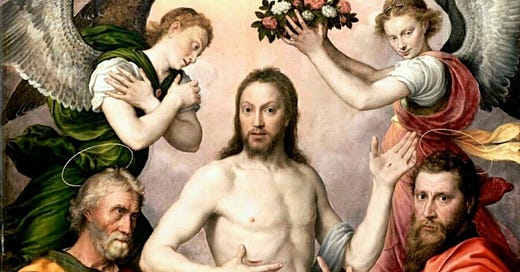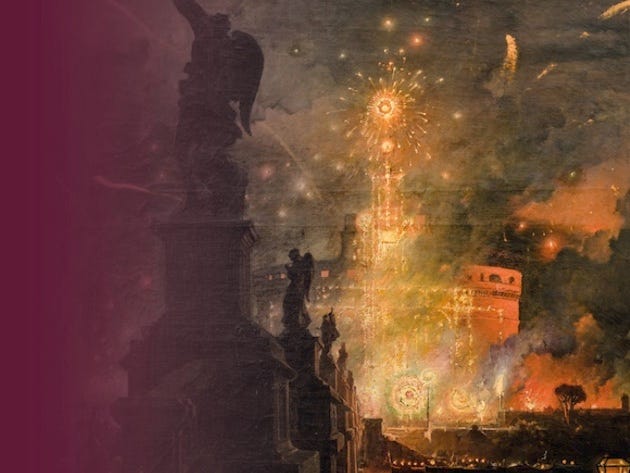Happy Feasts of Sts. Peter and Paul
This day has been consecrated for us by the martyrdom of the blessed apostles Peter and Paul. It is not some obscure martyrs we are talking about. Their sound has gone out into all the earth, and their words to the ends of the world (Psalm 19:3-4 LXX). These martyrs had seen what they proclaimed; they pursued justice by confessing the truth, by dying for the truth.
The blessed Peter, the first of the Apostles, the ardent lover of Christ, who was found worthy to hear, "And I say to you, that you are Peter" (Mat 16:13-20). He himself, you see, had just said, "You are the Christ, the Son of the living God." Christ said to him, "And I say to you that you are Peter, and upon this rock I will build my Church." Upon this rock I will build the faith you have just confessed. Upon your words, "You are the Christ, the Son of the living God," I will build my Church; because you are Peter. Peter comes from petra, meaning a rock. Peter, "Rocky", from "rock"; not "rock" from "Rocky". Peter comes from the word for a rock in exactly the same way as the name Christian comes from Christ.
Before his passion the Lord Jesus, as you know, chose those disciples of his whom he called apostles. Among these it was only Peter who almost everywhere was given the privilege of representing the whole Church. It was in the person of the whole Church, which he alone represented, that he was privileged to hear, To you will I give the keys of the kingdom of heaven. After all, it is not just one man that received these keys, but the Church in its unity. So this is the reason for Peter's acknowledged pre-eminence, that he stood for the Church's universality and unity, when he was told, To you I am entrusting, what has in fact been entrusted to all. To show you that it is the Church which has received the keys of the kingdom of heaven, listen to what the Lord says in another place to all his apostles: "Receive the Holy Spirit; and immediately afterwards, Whose sins you forgive, they will be forgiven them; whose sins you retain, they will be retained (John 20:22-23).
Quite rightly, too, did the Lord after his resurrection entrust his sheep to Peter to be fed (John 21: 15-19). It is not, you see, that he alone among the disciples was fit to feed the Lord's sheep; but when Christ speaks to one man, unity is being commended to us. And he first speaks to Peter, because Peter is the first among the apostles. Do not be sad, Apostle. Answer once, answer again, answer a third time. Let confession conquer three times with love, because self-assurance was conquered three times by fear. What you had bound three times must be loosed three times. Loose through love what you had bound through fear. And for all that, the Lord once, and again, and a third time, entrusted his sheep to Peter.
There is one day for the passion of two apostles. But these two also were as one; although they suffered on different days, they were as one. Peter went first, Paul followed. We are celebrating a feast day, consecrated for us by the blood of the apostles. Let us love their faith, their lives, their labors, their sufferings, their confession of faith, their preaching.1— St. Augustine
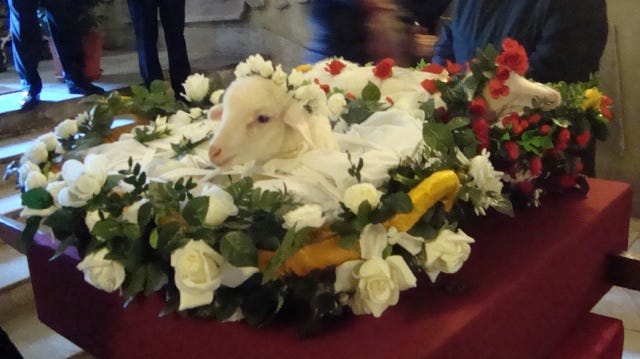
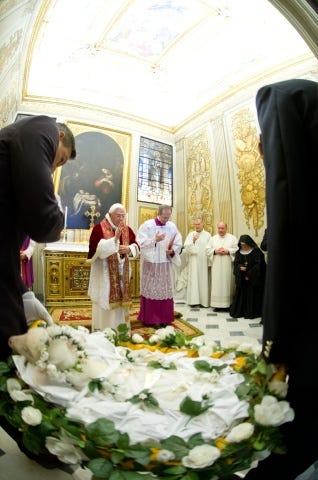
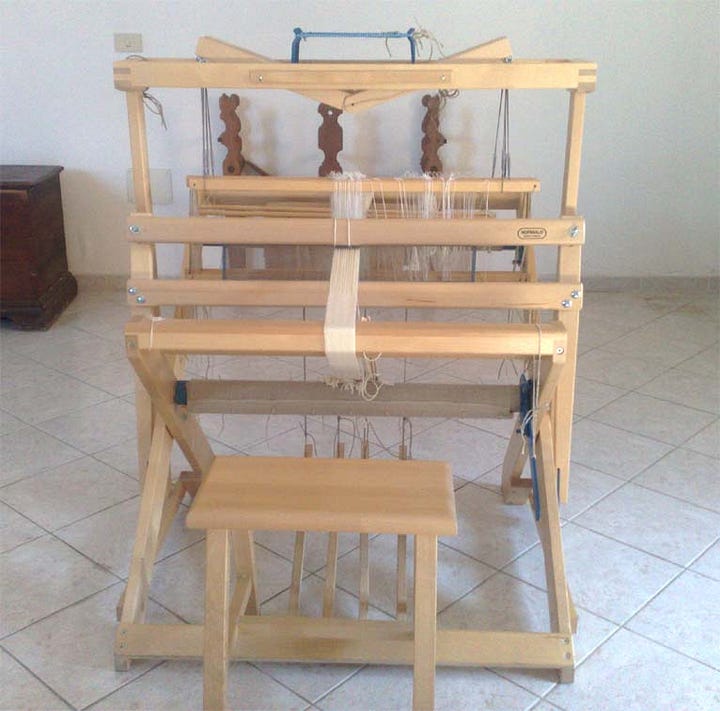

At the Trappist abbey associated with the church San Paolo alle Tre Fontane in Rome -- the grotto of which being the place where St. Paul was beheaded -- lambs are raised by the monks. Those lambs are brought by nuns to the altar at the church of Saint Agnes Outside the Walls (Sant'Agnese fuori le mura), where they are blessed by the Pope on the Feast of St. Agnes (January 21). Then, Benedictine nuns who have charge over the church of Santa Cecilia in Trastevere weave these lambs' wool into pallia, which are given by the Pope to metropolitan archbishops in St. Peter's Basilica on the eve of the Feast of SS. Peter and Paul. Pallia (the singular of the word is "pallium") are stole-like vestments that were formerly only worn by Popes, but are now worn by metropolitans as well. They're worn looped around the neck, over the chasuble, such that the ends drape down in the front and in the back.2
It used to be that, after their wool was harvested, the blessed lambs would be slaughtered just before Easter and have a final duty of feeding the Pope.
There is another story about San Paolo alle Tre Fontane where St. Paul was beheaded: In 1947, a Catholicism-hating, Seventh Day Adventist-style Protestant named Bruno Cornacchiola was at the grotto with his children. Bruno's wife followed him into Protestantism, but with great reluctance: she begged her husband to make the Nine First Fridays devotion, and only after it hadn't seemed to work to convert him did she follow him out of the barque of Peter. Now, while his children played in the grotto, he was preparing an anti-Marian speech to deliver to his Protestant friends -- and fine-tuning his plans to murder Pope Pius XII (he'd even purchased a dagger which he had inscribed with the words "Death to the Pope"). While going about his evil plans, he heard his children yell that the ball they'd been playing with had been lost, and went to help them find it. But by the time he reached them, he found them kneeling in ecstasy, repeating the words "Beautiful lady!" Then he, too, saw the Blessed Virgin, adorned in a green mantle over a white gown, with a pink sash around her waist. In her hands she held the Bible. She said to him, "I am the Virgin of the Revelation. You persecute me. Enough now! Return to the Holy Fold on earth!" She gave him a message to deliver to the Pope, who had yet to formalize the dogma of the Assumption: she said to tell him that "my body could not decay and did not decay. My Son and the angels took me to heaven." She revealed to him that his practice of the Nine First Fridays devotion that his wife begged him to undertake had saved him. And then she told him to go to priests and say "Father, I must talk to you" -- and pay attention to the priest who responds with "Hail Mary, my son, what do you want?" She then turned toward St. Peter's Basilica, took two steps, and disappeared. Bruno went to priest after priest trying to find the one who'd respond as Mary indicated, but had no "luck" until his wife recommended he go to the local parish. He did, and found the priest he sought, who formally reconciled him with the Church. He went on to deliver the message to Pope Pius XII, and the dogma of the Assumption was formally declared a few years later, in 1950. Since this apparition, the grotto has become a place of miracles...
On the morning of this feast, a great fishing net is hanged on the gates of Vatican City. Inside St. Peter's Basilica, the ancient bronze statue of St. Peter is adorned with the vestments of a Pope, complete with the triple tiara. The present Pope kisses the statue's foot -- something millions of pilgrims have done over the centuries, along with touching it -- so much so that the bronze of the foot is worn down and more resembles a stump.
The city of Rome, which has SS. Peter and Paul as its patrons, goes very quiet on this day in terms of business and everyday activities. The Via della Conciliazione, which leads to St. Peter's Square, is lavishly decorated, especially with lots of flowers (this is called the "infiorata"). After the day's Masses and a regatta, "la girandola" takes place -- a great fireworks display at the Castel Sant'Angelo. La girandola -- which means "pinwheel" -- was made into the especially elaborate display it still is today by the great Michelangelo.
Born in 1481 under the pontificate of Pope Sixtus IV, who entrusted the design of the machines for the fireworks, true works of engineering, to the most talented artists of his time, the Pinwheel was renewed by the imagination and creativity of Michelangelo Buonarroti, and then enriched with new plays of light, colors and sounds by Gian Lorenzo Bernini, who, taking inspiration from the power of the Stromboli volcano, made it even more exciting. Since the 15th century, the Pinwheel has been celebrated by poets and painters, witnessed in the stories of the Grand Tour and immortalized on canvas by numerous European artists. Today Castel Sant'Angelo, with its silent and imposing mass, becomes the ideal backdrop for this luminous ritual that is renewed every year, continuing to fascinate everyone.3
In Malta, the feast begins when the Novena to SS. Peter and Paul does, so it lasts for nine days. It's filled with music, food, fireworks, and, especially light -- so much so that the feast is known there as " L'Imnarja" (the Maltese word for luminaria).
A fun folk tradition for this feast begins on its eve: In Italy (especially in the northern regions), on the night between June 28 and June 29, children fill a large, clear glass jar full of cold water and gently drop into it the white of a very fresh egg. Without stirring or shaking the jar, they leave it uncovered outside in the grass, in an open field, or under a tree to "absorb the dew." In the morning they'll find "la barca (or barchetta) di San Pietro" -- St. Peter's fishing boat. The egg's albumen takes the shape of a ship's sails, you see, which the children are told happens because St. Peter blows into the jar. Upon seeing the ship, the children say, "È vero, è vero, è arrivato San Piero!" ("It's true, it's true, Saint Peter has arrived!"). Legend says that if the sails are open, the weather will be nice and placid, but if the sails are closed, rain is imminent.
https://fisheaters.com/feastofsspeterandpaul.html
https://www.benedettinesantacecilia.it/?page_id=646
https://www.turismoroma.it/en/events/pinwheel-castel-santangelo-2025

